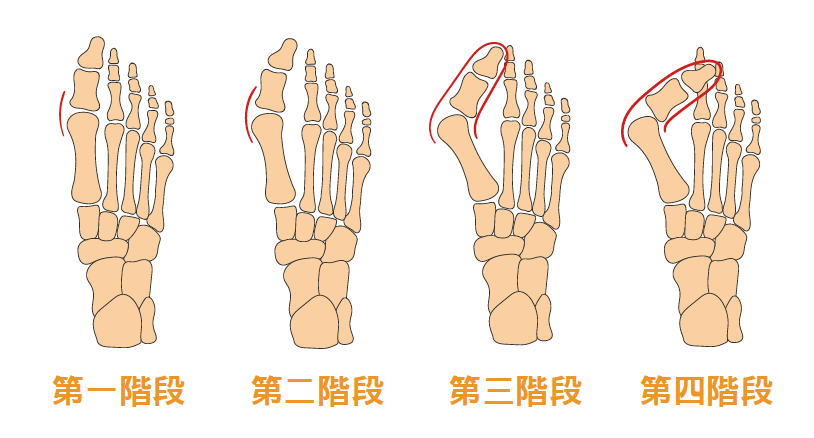Hallux valgus is a very common problem related to age, disease, and genetics, such as women wearing high heels or narrow toe shoes for a long time, and adding toe pressure can easily cause hallux valgus. In addition, the shape of our feet will change with age, and people with rheumatoid arthritis and flat feet are also more likely to cause hallux valgus due to weaken and deformed plantar function.
What is hallux valgus?
The so-called hallux valgus means that there is a bone protruding from the outside of the big toe, sometimes red and swollen, and the position of the big toe is particularly painful when walking. Hallux valgus usually takes years before the foot bones are deformed. Four stages of hallux valgus: in the first stage, a slight protrusion of the bone on the outside of the big toe is perceived; After a while, the distance between the big toe and the second toe closes and begins to touch; In the next stage, the big toe presses against the second toe, and when walking, the big toe has pain, and the fascia of the first and second toes is especially painful; The fourth stage is the worst, and some people's big toes will be severely above or below the second toes, which is particularly painful when wearing shoes and walking. The reason why hallux valgus appears is usually related to the shape of the foot, for example, some patients have flat feet, flat feet do not have arches, the pressure will fall on the big toe and the second toe when stepping on the ground, and slowly the toe produces inflammation and gradually changes the bone shape. Older people have hallux valgus because the big toe suffers from arthritis, and hallux valgus also occurs. In fact, the most common cause of hallux valgus is wearing the wrong shoes, many women are used to wearing high heels, pointed heels are even more beautiful, but if you wear pointed toe high heels for a long time, the toe does not have enough space for the toes to stretch, which is equivalent to making the toes under the pressure of the whole body weight for a long time every day. In addition to high heels, pointed-toe sneakers have a tight toe space that can also cause pressure on the toes.

Since wearing the wrong shoes is the main cause of hallux valgus, how should we choose shoes? It is best to choose a round toe, which is round enough to provide enough room to stretch without putting a lot of pressure on the toes. There are some silicone that can correct mild or moderate hallux valgus and can be placed between the big toe and the second toe when sleeping at night as a tool to separate the toes. This corrective tool can be worn at different times of the day, and it is also a good choice to wear it for a while and let the toes loosen. In addition, you can also wear five-toe socks and put the toes into the five toe covers, or choose special shoes and separate each toe when wearing them, so that the toes can move freely, not only without pressure, but also train the stability of the soles and toes when walking. If you have flat feet, adding a special insole to your shoes can also help reduce pressure on the arch of the foot. Mild or moderate hallux valgus can be improved with simple exercises.
Five exercises to improve the hallux valgus
First exercise
The first two exercises are relaxation and the last three exercises are training. Hallux valgus is when the big toe presses against the second toe, which means that the muscle between the big toe and the second toe is too contracted and tightened, and this muscle must be relaxed first. First pull the big toe outward, and push the second toe and the big toe in the middle of the second toe and the big toe from the ankle direction to the toe and press for one minute.
Second exercise
The protruding joint is always in pain because the hallux valgus, and it must be allowed to move. The hand grasps the big toes joint and moves it in a circle, making several continuous movements.
The third exercise
This exercise is mainly to train the muscles, and it is necessary to prepare a slightly thicker rubber band to cover the inside of the entire toe. The purpose of the movement is to exercise the lateral muscles of the hallux toe to counteract the pressure of the inner contraction, so the whole toe must be covered with force to be even. When operating, open the feet, the heels do not need to move, the big toes of the two feet pull the rubber band outward, and then return to the middle. Repeat the action 20 times.
The fourth exercise
This movement also uses rubber bands, which is a functional training. The principle is to use the small muscles of the foot surface and the small muscles of the foot plate to improve the structure of the entire sole. Open both feet, first the big toes of both feet firmly stretch the rubber band, then the other toes spread and flatten, then raise the heels and lower again. Repeat the action 20 times.
The fifth exercise
This exercise is also a functional exercise, similar to the fourth one, but it is supported with the strength of the hips when lifting the foot. The same is to open the feet, the big toes of the feet stretch the rubber band, then the other toes to spread and flat, and then raise the heels, at this time the hips should tighten the support feet and then slowly lower the foot. Repeat the action 20 times.

 Book an Appointment
Book an Appointment


